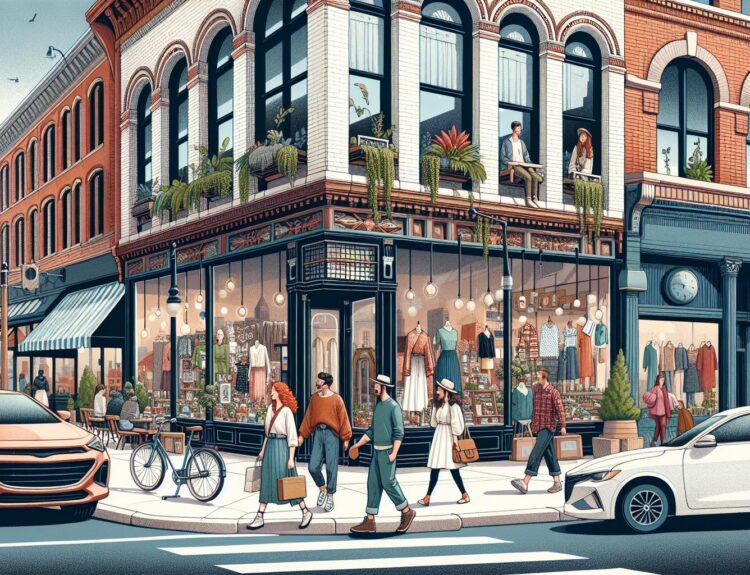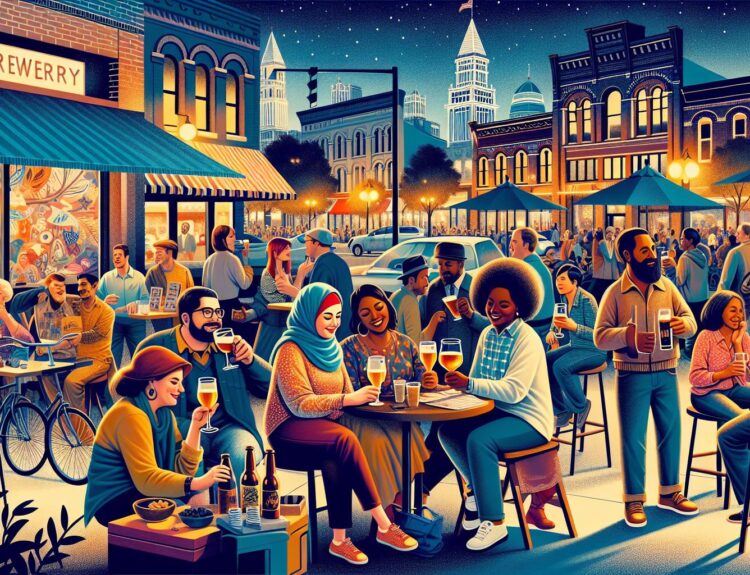I’ve always been fascinated by the unique charm that different neighborhoods in Detroit offer. Corktown and Eastern Market, each with their distinct vibes, have been on my radar for a while. It’s like they’re competing siblings, each trying to outshine the other with their own quirks and treasures.
Corktown, with its cozy, historic feel, whispers stories of the past through its beautifully aged buildings. It’s a place where tradition meets trendy, creating a blend that’s hard to resist. On the flip side, Eastern Market bursts with vibrant energy every weekend, drawing in crowds with its colorful murals, fresh produce, and an undeniable sense of community.
Deciding which neighborhood steals your heart is a tough call. They both offer such rich experiences but in very different ways. Let’s dive into what makes each of them stand out and see if we can pick a favorite.
History of Corktown and Eastern Market
When I first wandered into Corktown, its historical charm was unmistakable. Known as Detroit’s oldest neighborhood, Corktown’s roots go back to the 1830s when it became home to Irish immigrants fleeing the Great Famine. This heritage is still palpable; from the street names to the architecture, the spirit of those early settlers weaves through the area like a vibrant tapestry. Walking its streets, I’ve often marveled at how these historical buildings, some beautifully preserved and others charmingly worn, tell stories of resilience and community.
In contrast, Eastern Market’s story began in the 1850s, growing to become one of the oldest and largest year-round markets in the United States. It’s not just a market, but a cultural hub where farmers, artisans, and patrons from all over Michigan and beyond come together. This place has always been more than a spot to grab fresh produce; it’s where people meet, exchange ideas, and witness the community in its most dynamic form. Every visit brings me face to face with the colorful murals that celebrate Detroit’s history, creativity, and spirit. These art pieces, coupled with the historic sheds and bustling crowds, create an atmosphere where past and present meld seamlessly.
Corktown’s evolution has also been marked by the introduction of contemporary restaurants and businesses, nestling alongside longstanding establishments. This blend of old and new maintains the neighborhood’s character while welcoming innovation and growth. It’s thrilling to see how the community supports these ventures, ensuring Corktown continues to thrive without losing sight of its roots.
Eastern Market, on the other hand, has expanded its role in the community far beyond a traditional market. With events like Flower Day drawing massive crowds and initiatives aimed at supporting local agriculture and businesses, the market has breathed new life into the area. It’s fascinating to witness Eastern Market during these bustling times; the air fills with a sense of togetherness that’s hard to find elsewhere.
Both neighborhoods embody the spirit of Detroit’s revival, yet they each maintain distinct identities shaped by their storied pasts. As I dive deeper into the histories of Corktown and Eastern Market, I’m reminded that understanding these roots is key to appreciating their present vibrance and future potential. Each visit, conversation, and moment spent in these spaces connects me more deeply to Detroit’s rich tapestry of stories.
Architecture and Aesthetics
Walking through the streets of Corktown, I’m always impressed by the beautiful blend of old and new. It’s a neighborhood where every building tells a story, from the quaint worker’s cottages that housed Irish immigrants in the 19th century to the modern infusions of contemporary architecture. There’s something incredibly special about seeing a historical home next to a sleek new business, both contributing to the neighborhood’s unique character. The preservation of historic structures alongside innovative designs is something Corktown has mastered.
One of the jewels of Corktown is the Michigan Central Station, a once-abandoned train station that’s currently undergoing renovation. Its looming structure has always been a striking example of Beaux-Arts architecture, and as it’s brought back to life, it symbolizes the rejuvenation of the area itself. Nearby, the old Tiger Stadium site, now a field for local youth and the community, adds to the area’s historic charm, reminding us of Detroit’s rich sporting history.
Transitioning to Eastern Market, the vibe shifts dramatically. Here, the aesthetics lean more towards the industrial and artistic, with large murals and public art installations breathing life into the old market buildings and warehouses. The market sheds, some dating back to the early 20th century, showcase a robust industrial design that has efficiently served the area for decades. These structures are functional yet beautiful, hosting hundreds of vendors and attracting thousands of visitors every week.
What’s particularly striking about Eastern Market is its commitment to public art. The Murals in the Market initiative has transformed the district into a canvas, celebrating local and international artists alike. Everywhere you look, there’s a splash of color, a story painted on the walls of the very buildings that house the market’s vibrant life. This blend of art and commerce in an urban setting not only makes Eastern Market a cultural hotspot but also highlights the city’s dedication to supporting the arts and local businesses.
In both Corktown and Eastern Market, the architecture and aesthetics are deeply intertwined with each area’s history and present-day identity. Corktown enchants with its historical preservation and modern touches, while Eastern Market bursts with industrial grace and artistic flair. As I move from one neighborhood to the other, I can’t help but appreciate how each uses its physical space to tell the ongoing story of Detroit’s evolution and resilience.
Culinary Delights
When I dive into Corktown’s culinary scene, it’s impossible not to feel an instant connection to the soul of Detroit. This neighborhood doesn’t just serve food; it serves stories on a plate, blending history with a modern palate. Slows Bar BQ stands out as a prime example. Its story of growth parallel to the city’s own rejuvenation has made it a landmark not only for locals but also for anyone curious about Detroit’s tenacity. Their brisket? A must-try. It pulls you into the narratives of Corktown, bite by bite.
But it’s not just about barbecue. Corktown’s eclectic mix of dining establishments encompasses everything from upscale gastronomy to cozy cafes. Astro Coffee offers a hip, yet unpretentious atmosphere where the art of brewing coffee reaches peak perfection. The pastries, a blend of local ingredients and global culinary techniques, hint at Detroit’s diverse cultural tapestry. Walking through Corktown, the evolution of its food scene becomes apparent, mirroring the transformation of the neighborhood itself.
Shifting focus to Eastern Market, the experience is distinctly different but equally mesmerizing. As America’s oldest and largest year-round market, the options here are unparalleled. Saturdays in Eastern Market present a vibrant tableau of local farmers, artisans, and producers offering goods that span the spectrum of taste and culture. The Eastern Market Shed 2, especially, is a gastronomic haven where one can find everything from fresh local produce to exotic spices.
Among the cafes and restaurants scattered around the market, Supino Pizzeria offers a slice of heaven that perfectly captures Eastern Market’s bustling and vibrant essence. With its thin crust pizzas, boasting both traditional and inventive toppings, it’s a spot where simplicity meets sophistication. The energy in Eastern Market is infectious, driven by the community’s passion for food and fellowship.
Beyond the market stalls, mural-covered warehouses, and the hustle of commerce lies a culinary experimental space. The Detroit Kitchen Connect program in Eastern Market stands as a testament to the district’s commitment to nurturing culinary entrepreneurship. By providing commercial kitchen space to emerging food entrepreneurs, Eastern Market fosters innovation and inclusion in Detroit’s food scene.
Community Vibrancy
When I first set foot in Corktown, the thing that stood out to me most wasn’t just the historical architecture or the tantalizing smells wafting from the local eateries—it was the palpable sense of community. Walking through the streets, I encountered murals that spoke volumes about local culture and history, with vibrant colors that seemed to bring the neighborhood’s stories to life. Corktown’s community vibrancy is a patchwork of the past and present, where every storefront and sidewalk has a tale to tell. Locals, many of whom have lived here for generations, are more than happy to share anecdotes about Corktown’s transformation, knitting a rich tapestry of shared memories and collective hopes.
Eastern Market, on the other hand, pulsates with a different kind of energy. Here, the community vibrancy is most visible on market days when farmers and artisans from across Michigan come together under the historic sheds. The air buzzes with the chatter of shoppers and the calls of vendors, creating a symphony of sounds that is as diverse as the goods being sold. Relationships are forged over fresh produce, with conversations flowing easily amidst the vibrant stalls. Eastern Market isn’t just a place to buy your groceries—it’s where you come to connect, to discover, and to participate in a tradition that’s been ongoing for over a century.
In both neighborhoods, community events play a significant role in strengthening the local fabric. Corktown hosts an array of festivities, from its renowned St. Patrick’s Day Parade to street fairs that celebrate the area’s rich Irish heritage and its growing diversity. Eastern Market, for its part, expands its role beyond a marketplace by hosting cooking classes, evening bazaars, and the seasonal Flower Day, drawing in crowds from all walks of life.
Here’s a quick glance at the kind of events you might find in each area:
| Event Type | Corktown | Eastern Market |
|---|---|---|
| Cultural | St. Patrick’s Day Parade | Flower Day |
| Community | Street Fairs | Cooking Classes |
| Seasonal | Summer Festivals | Evening Bazaars |
Making the Choice
Deciding between Corktown and Eastern Market isn’t simple; it’s like choosing between two flavors of your favorite ice cream. Each has its charm, its vibrant community, and its unique offerings to the city of Detroit. I’ve spent considerable time in both, soaking up the ambiance, the culture, and of course, the food.
In Corktown, it’s the sense of history that grabs you first. Walking down Michigan Avenue, you’re following in the footsteps of countless others who’ve witnessed the evolution of Detroit’s oldest neighborhood. The beautifully restored Victorian homes serve as a backdrop to a thriving indie business scene – from cozy coffee shops to renowned restaurants like Slow’s BBQ, each with a story to tell. But it’s not just about the past; Corktown is very much about the present and the future. The recent influx of new development, including the much-anticipated Michigan Central Station renovation, promises to bring even more energy and investment into the area.
Then there’s Eastern Market, a place that’s synonymous with Saturday mornings filled with fresh produce, vibrant flowers, and the hum of people gathering. It’s more than a market; it’s a community hub where farmers, chefs, and artists converge. The district spans several blocks, with murals painting a visual feast on the sides of historic market sheds and warehouses. Beyond the market days, Eastern Market serves as a canvas for Detroit’s burgeoning art scene, hosting galleries and studios that breathe new life into old buildings. And let’s not forget about the food – from authentic Italian to Detroit-style pizza, the area is a foodie’s delight.
Both neighborhoods offer a unique taste of Detroit, but your preference might hinge on what you’re looking for. If history and a close-knit community vibe call out to you, Corktown might be your spot. On the other hand, if you thrive in the energy of a bustling market and have an appetite for art and culinary exploration, Eastern Market might just steal your heart.
Conclusion
Deciding between Corktown and Eastern Market feels a bit like choosing a favorite song. It’s tough because each has its own rhythm that resonates differently with everyone. For me, the allure of Corktown’s historic charm and indie spirit is hard to resist. But then again, Eastern Market’s vibrant energy and artistic flair always leave me wanting more. Ultimately, whether you’re drawn to Corktown’s cozy community vibe or Eastern Market’s dynamic cultural scene, you’ll find a piece of Detroit that feels just right. And isn’t that the beauty of exploring this city? Each neighborhood tells a story, and I can’t wait to discover more.






